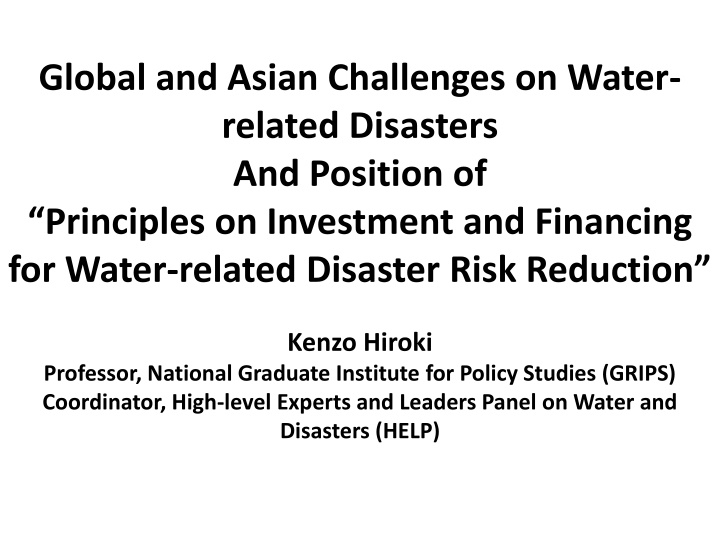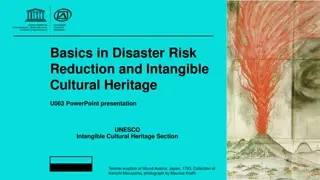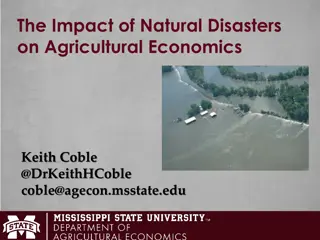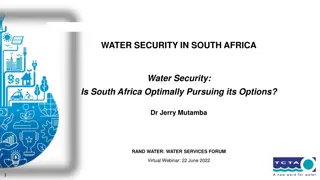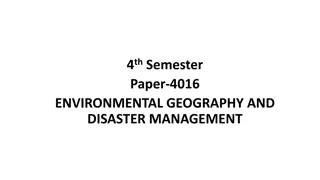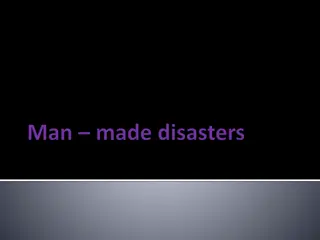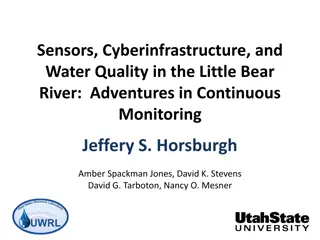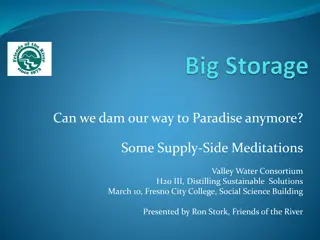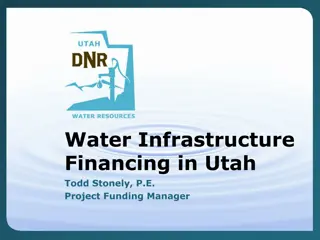Challenges and Solutions in Water-Related Disasters
Exploring the global and Asian challenges posed by water-related disasters, this presentation by Kenzo Hiroki delves into the importance of investing in disaster risk reduction. Highlighting the increasing frequency and impact of natural disasters, particularly those related to water, the images and data presented underscore the urgent need for proactive measures. With millions affected by floods, droughts, storms, and earthquakes, the call to action is clear: enhance preparedness to avoid repeating tragic outcomes.
Download Presentation

Please find below an Image/Link to download the presentation.
The content on the website is provided AS IS for your information and personal use only. It may not be sold, licensed, or shared on other websites without obtaining consent from the author.If you encounter any issues during the download, it is possible that the publisher has removed the file from their server.
You are allowed to download the files provided on this website for personal or commercial use, subject to the condition that they are used lawfully. All files are the property of their respective owners.
The content on the website is provided AS IS for your information and personal use only. It may not be sold, licensed, or shared on other websites without obtaining consent from the author.
E N D
Presentation Transcript
Global and Asian Challenges on Water- related Disasters And Position of Principles on Investment and Financing for Water-related Disaster Risk Reduction Kenzo Hiroki Professor, National Graduate Institute for Policy Studies (GRIPS) Coordinator, High-level Experts and Leaders Panel on Water and Disasters (HELP)
Glimpse of a water-related disaster, March 11th, 2011 Viewed from Kamaishi City Hall
Why Water and Disasters? We should not repeat the Tragedy for our family, people, and nation
Disasters are increasing in numbers and impacts
Number of reported natural disasters(1900-2010) 500 400 300 200 100 Year Source: ISDR EM-DAT
Estimated damage caused by natural disasters (1900-2010) 200 Billion USD 100 Year Source: ISDR EM-DAT
Number of people affected by disasters (1994-2013) Earthquake: 121 million (3 %) 93 million (2 %) Storm: 660 million (15%) Total: 5.7 billion Temperature: Drought: 1.4 billion (25%) Flood: 2.4 billion (55%) Flood Drought Storm Earthquake Temperature Others Source: CRED The human cost of natural disasters 2015
Number of people affected by disasters (1994-2013) Earthquake: 121 million (3 %) 93 million (2 %) 95% of disasters are water- related disasters Storm: 660 million (15%) Total: 5.7 billion Temperature: Drought: 2.4 billion (25%) Flood: 2.4 billion (55%) Flood Drought Storm Earthquake Temperature Others Source: CRED The human cost of natural disasters 2015
Number of people affected by disasters (1994-2013) Earthquake: 121 million (3 %) 93 million (2 %) Anybody on earth will be hit by disasters twice in his/her life time on average, mostly by water-related disasters, sometimes fatal. Storm: 660 million (15%) Total: 5.7 billion/20 years Temperature: Drought: 2.4 billion (25%) Flood Drought Storm Flood: 2.4 billion (55%) Earthquake Temperature Others Source: CRED The human cost of natural disasters 2015
The world has lost 2.7 trillion USD in 20 years (1995- 2015) by disasters. 70 % of the loss by water-related disasters
Water and Disasters is strongly linked to poverty issue
Number of fatalities by floods (2001- Number of fatalities by floods (2001-2010) 2010) - 70 % of human loss by flooding are from low income or lower middle income countries - 1,385 2% Low Income: 23% Low income 13,796 23% Lower middle income 17,613 30% Upper middle income High income 26,601 45% Lower Middle Income: 45% High-income economies ($12,276 or more) Upper-middle-income economies ($3,976 to $12,275) Lower-middle-income economies ($1,006 to $3,975) Low-income economies ($1,005 or less) Water and disasters are strongly linked to poverty issues 13
Number of disaster deaths per one million inhabitants by income groups (1994-2013) 40 30 20 10 0 High- income Upper Middle- income Low- income Lower Middle- income
Principles on Investment and Financing for Water-related Disaster Risk Reduction
Response of Global Community to Ever-increasing Disasters and Their Impacts
Disaster management is gaining importance within governments Perceived change in the importance of disaster management over the past 20 years Significant decrease Slight increase Significan t increase Slight decrease No change Status Report on Integrated Water Resources Management and Water Efficiency Plans. UN-Water. 2008 70% of countries think disasters have become more important among the government priorities 17
Six Targets of SDG6 Comprehensive goals and targets on water The targets are related to other development agenda such as health, food, education, and gender Each of Targets has indicator(s) and monitoring agencies
Four Priorities for Action of Sendai Framework 1.Understanding disaster risk. 2.Strengthening disaster risk governance to manage disaster risk. 3.Investing in disaster risk reduction for resilience. 4.Enhancing disaster preparedness for effective response and to Build Back Better in recovery, rehabilitation and reconstruction.
Principles on Investment and Financing for Water- related Disaster Risk Reduction Background Investing in disaster risk reduction for resilience as one of the four priority actions in the Sendai Framework By 2030, significantly reduce substantially decrease the direct economic losses caused by disasters, including water- related disasters as SDG Target 11.5 We commit to promote disaster risk reduction and management, through supporting the development of disaster risk reduction strategies and periodical assessments of disaster including standards for risk levels (HABITAT III) 20
High Level Panel on Water (HLPW) convened by UN Secretary-General and President of the World Bank Group
High Level Panel on Water (HLPW) Special Advisor Emomalii Rahmonov President Tajikistan J nos der Dr. Han Seung-soo Kevin Rutte President Hungary Prime Minister Netherlands Former Prime Minister, Republic of Korea Macky Sall President, Senegal ` ` ` Abdullah Ensour Prime Minister Jordan Enrique Pe a Nieto President, Mexico Ameenah Gurib-Fakim President, Mauritius Co-chairs ` ` ` Sheikh Hasina Prime Minister Bangladesh Malcolm Turnbull, PM Australia ` ` Pedro Kuzynski President Peru Jacob Zuma President South Africa ` Co-convened by: Home Jim Yong Kim President World Bank Group Antonio Guterres UN Secretary-General UNITED NATIONS
HLPW Action Plan 9 Areas of Action 1. Catalyzing Changes, Building Partnerships and International Cooperation 2. Resilient Economies, Societies, and Disaster Risk Reduction 3. Universal Access to Safe Water and Sanitation 4. Sustainable Cities and Human Settlements 5. Water and the Environment 6. Infrastructure and Investments 7. Water Governance 8. Water Data 9. Valuing Water 23
Recommendations on Disaster Risk Reduction in HLPW Outcome Document HEADLINE RECOMMENDATION Shift focus of disaster management from response to preparedness and resilience DETAILED RECOMMENDATIONS Financing for and investment in water-related DRR and resilience should be doubled within the next five years. Principles on Investment and Financing should be used to make effective use of this increased investment and could help increasing investments in countries. 24
Challenges the Principle need to address Sometimes the biggest hurdle is convincing the government to decide and commit to financing infrastructure (USACE) Risk prevention should be integrated with long-term planning and create opportunities for synergies with planned investments (Netherlands) Investment for disaster prevention needs to be strengthened for protection of economic development gains and consistent progress of the economic growth. (Japan) There is a need for long term financing strategies to improve resilience particularly at the national government level. (OECD) It is also important to look into innovative financing. Insurance industry is least developed in developing countries. (UNESCAP) Organizations such as donors will need to increase the amount of investment. (KOICA) Disaster risk reduction is not merely a cost, but an investment for stronger development which pays off in the future. (JICA) 25
Objectives of the Principle Build convincing arguments and logics (e.g. addressed to Finance Ministry) that disaster risk reduction pays off Establish standardized methodology to analyze cost of water-related disasters, particularly indirect cost Create portfolio of innovative/alternative financing for water-related disaster risk reduction Promote identifying and sharing good practices on financing and investing in water-related DRR Recommend legal/administrative/budgetary system that ensures long-term financial flow for DRR investment Recommend strategies to make the above to happen in countries 26
Chronology towards Finalization of the Principles 2015- 2018 Mar. 15 May 3 Aug. 26 Oct. 9 Global Community prioritizes financing DRR (SDGs, Sendai, Habitat III) HLPW recommended creation of the Principles Announcing Draft Principle in the 12thHELP Meeting, Geneva Global Consultation Meeting I on the Principles in Stockholm WWW 1stRegional Consultation Workshop on the Principles in Central and Eastern Europe in Bucharest, Romania 2ndRegional Consultation Workshop on the Principles in South West Asia, in Colombo, Sri Lanka 3rdRegional Consultation Workshop on the Principles in Africa in Livingstone, Zambia Oct. 12 Nov. 1 2019 Feb. 28 Mar. 22 Apr. 18 Apr. 23 June 24 July- Global Consultation Meeting II in OECD, Paris 4thRegional Workshop on the Principles in Hanoi, Vietnam Global Consultation Meeting III in the Hague, the Netherlands 5thRegional Consultation Workshop in Montevideo, Uruguay Launching the Principles in the 4thUN Special Thematic Session on Water and Disasters in UN-HQs, New York Operationalizing the Principles in the World
